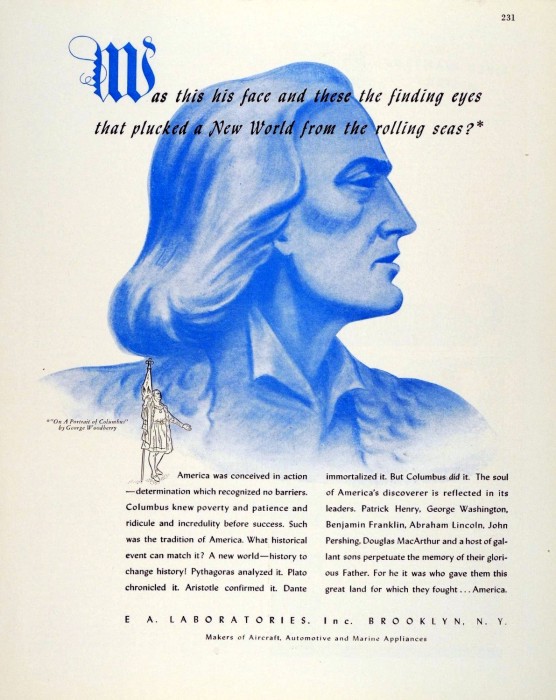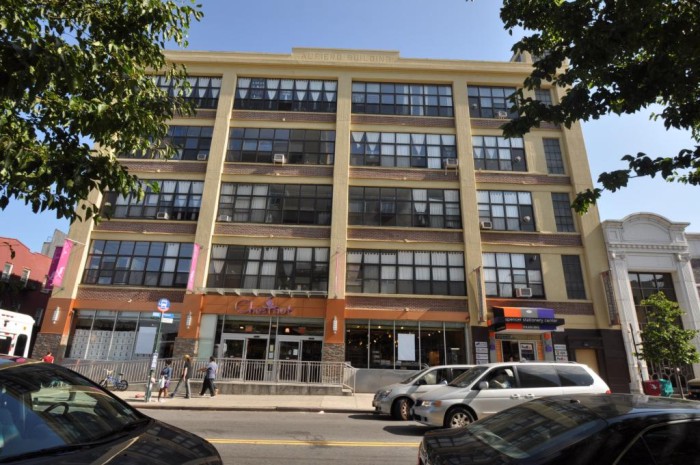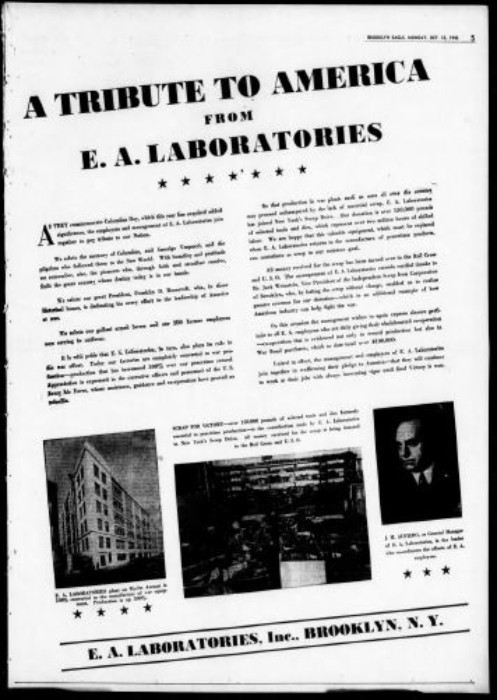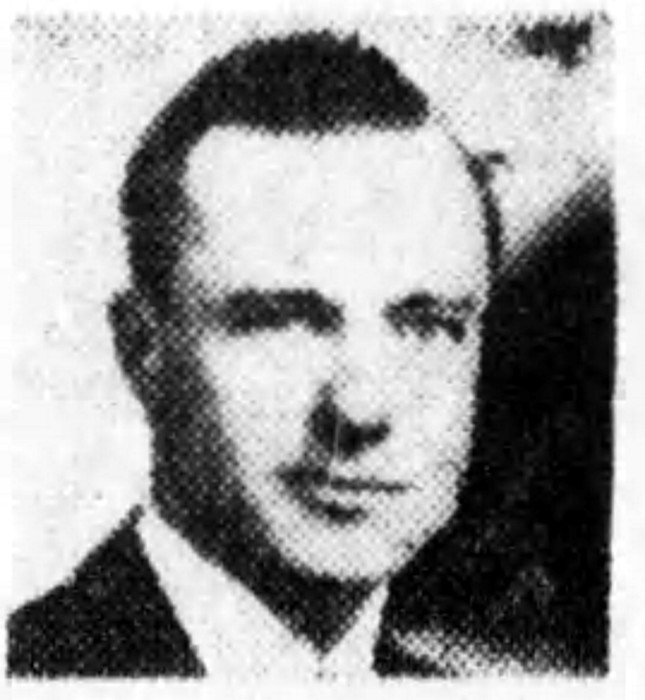Walkabout: A Honking Good Idea – E. A. Laboratories, Part 2
Read Part 1 and Part 3 of this story. In 1929, Emanuel Aufiero, the president of E. A. Laboratories, the makers of the best car, motorcycle and bike horns around, had a nervous breakdown. His life had been an immigrant success story – a young man comes to America from Italy in the new century,…


Read Part 1 and Part 3 of this story.
In 1929, Emanuel Aufiero, the president of E. A. Laboratories, the makers of the best car, motorcycle and bike horns around, had a nervous breakdown. His life had been an immigrant success story – a young man comes to America from Italy in the new century, and becomes a success in the field of automotive accessories.
His designs and innovations are snapped up by the largest manufacturer of such items in the country, and he is paid more money than he’s ever imagined in his life. He marries, has children, and is living in Brooklyn, where he is respected and admired. What more could anyone want? Part One of our story introduces our characters and their products.
Success was not entirely all it was imagined to be. Aufiero was indeed a genius in his field, and he had produced dozens of designs for his employer, the Automobile Supply Company of Brooklyn. But he was ill-advised, or just hoodwinked on the terms of his contract. Early on, he had signed a very restrictive and exclusive contract with Louis Rubes, the president of ASC.
That contract gave his employer the lifetime rights to all designs produced for manufacture by ASC, and also the rights to anything Aufiero ever came up with in the future, even if he was no longer working for ASC. That, of course, guaranteed that Aufiero would never leave ASC’s employ, because what was the point of another company hiring him to design goods, when that company could not produce them without paying Rubes a cut of the profits?
As can be expected, Aufiero wanted out from his contract. He and his brother decided to form their own company and manufacture automotive accessories that he had never shown to Rubes. They rather rashly named their company E. A. Laboratories, and began work in a small workshop in Manhattan. When Rubes found out, he sued.
In deposition and trial, he said that ASC had paid Aufiero handsomely for his designs, and was being repaid by treachery. Aufiero was in breach of contract, he asserted, and had to close his factory, and in addition, give the new designs and proceeds thereof, to Rubes, as technically, they belonged to him.
UPDATE: The grandnephew of Louis Rubes contacted Brownstoner with a letter regarding some of the late automobile company president’s personal history and family fortunes. You can read it at the end of Part 1.
Long story short, karma can be an angry female dog. Because of this lawsuit, as well as another similar suit Rubes had going on at the same time, his company went bankrupt, and he was a sick and broken man. His 500 employees were out of work, and the marshals were having an auction and sale of his factory and contents. Aufiero had won by default.
Emanuel was certainly happy about that, but the guilt made him sick. Several years later, the company had grown tremendously, taking over the marketplace that ASC had once commanded. They had built a new factory on the corner of Myrtle Avenue and Spencer Street, in a building named after him. Still, it was all too much; Aufiero had a nervous breakdown.
While Emanuel was recovering in a sanitarium, his wife Adele had the courts declare him incompetent, and all of his assets, including company stock, were turned over to her. He was in the sanitarium for less than a month. When he got out, and came home to resume his life, Emanuel found out that Adele had sold all of the stock to Emanuel’s youngest brother, John – almost $155,000 worth.
In order to get his possessions back, Adele wanted him to sign an agreement that stated that he would receive two-thirds of his estate back, but the remaining third would be in his wife’s name. She would also get $41,000 in cash, up front. Upon the event of his death, his portion of the estate would be divided between their children and her relatives. His relatives were out.
They told him that if he didn’t sign the agreement, then they were going to have him recommitted to the sanitarium, and he wouldn’t be getting out soon. He signed this second bad contract. This time, however, Emanuel Aufiero wasted no time in getting a lawyer and taking the case to the courts. He sued his wife, her brother, Marcello Bucci, the Bucci family, and for good measure, his son, Emanuel, Jr.
Adele’s lawyer, Armand C. Lopez, was seen as the mastermind of this agreement. Aufiero’s lawyer was former judge Charles C. F. Wahle. Mrs. Aufiero also was suing for separation, claiming that Aufiero was a cruel and demanding husband, and had been so since they got married in 1917.
She cited several instances where he had allegedly treated her cruelly. Mr. Wahle pointed out at trial that one of those instances had taken place when his client was in the sanitarium. Oops. Mrs. Aufiero’s lawyers asked for a continuance.
I couldn’t find out what happened next, but they may have settled. The case is not mentioned in the papers again. If the couple separated, which seems likely, they never divorced, but being Old World Italian Catholics, they probably wouldn’t, anyway. Younger brother John soon took over the presidency of the company. He was very good at it, and under his tenure, E. A. Laboratories continued to grow and add to its profitable line of accessories.
Emanuel continued to tinker in his lab, and by the beginning of the 1940s, they were supplying most of the domestic and international car manufacturers with product of some kind. The Laboratory had filled up their first five story factory building, and was now a new six story building next door, as well.
The company always had want-ads in the papers, was a union shop, and at times, could have even been a fun place to work, if the stories printed in the paper were true. After all, a car horn could be a funny thing.
In 1941, as America was teetering on the brink of entering World War II, some levity was offered in a Brooklyn Eagle article. It spoke of the jolt one could get by walking past the E. A. Laboratories, where the air was full of the sound of electronic car horns that could play any tune.
An early example of programming, the horns had disks inside that were imprinted with the short tune. You could get boogie-woogie tunes, military service themes, or “The Campbell’s are Coming.” They were even working on the opening strains of “the Ride of the Valkyries.” (I want that one!)
John Aufiero was interviewed, and the article spoke of the company’s commitment to the community, local charities for all faiths and causes, and John’s establishment of a trade school like his alma mater, Pratt Institute, in his native Italy.
The school was started in 1932, and was running in 1937. The article also mentioned that the company had been having some union and labor problems, but all was resolved. The labor issues would haunt the company, even as America got ready to enter World War II.
When the war started, E. A. Laboratories was called upon to stop production of auto horns, heaters and windshield wipers and move into wartime production. They now were churning out gun sights, ship landing lights and lights and other equipment for military aircraft. Production was upped by 300%, with the tool and die works running day and night. More people were hired, including women, who for the first time took over some of the factory work.
John Aufiero had been a veteran in World War I, and soon became very involved in his company’s war efforts. The plant was turned over to military production in record time. When scrap iron drives were held, E. A. Laboratories donated 150,000 pounds of manufactured tools and dies as well as other metal scrap.
The tools and dies, crafted specifically for their domestic production, represented two million man hours of work. The money from the sale of the scrap was further donated to the Red Cross and the USO. In 1942, the company took out a full page ad in the Eagle, celebrating America and touting their own patriotism.
EAL wanted those lucrative government contracts, but John Aufiero also had some skeletons in his closet that he was desperately trying to keep buried. His labor relations were not good. There had been several strikes against the company in recent years, and when the war broke out, he had just negotiated a tentative peace with the unions.
In 1944, the company was charged with not paying overtime, not keeping adequate records, and shipping interstate, violating the wage-hour law. They promised to pay all overtime owed, and clean up their record keeping and other offenses.
Then in 1945, at the height of the war, the closet burst open, and the skeletons began goose-stepping out. It turned out that John Aufiero had some strong fascist leanings. He had been a vocal admirer of Mussolini, and in his trips to Italy to visit his mother and relatives and set up his trade school, he may have even met Il Duce. He was also admirer of several other prominent Italian fascists, including the anti-Semitic fascist newspaper editor Domenico Trombetta.
In 1938, he had thrown a fundraising dance for a Fascist home for Italians abroad, located in Rome. He printed a souvenir book for the occasion which was full of praises for Benito Mussolini, his government, Trombetta and others. The statements in the journal had even been signed by Aufiero. At any other time, no one would have made much of it, or even noticed. But the United States was at war with Italy and its fascist government. Aufiero had government contracts for items that went into military airplanes. Can we say “Big Problem?”
Next time – the conclusion of the story.
(1942 wartime patriotic announcement from E.A. Laboratories. Source: Amazon.com)












What's Your Take? Leave a Comment